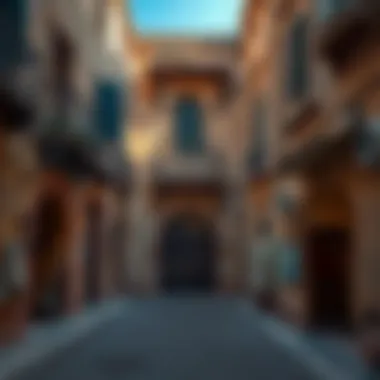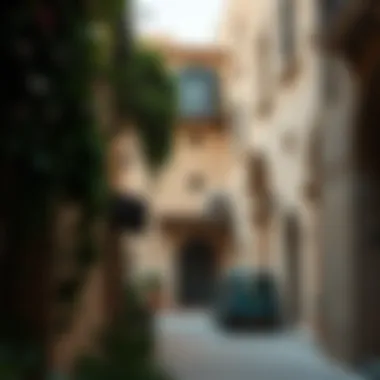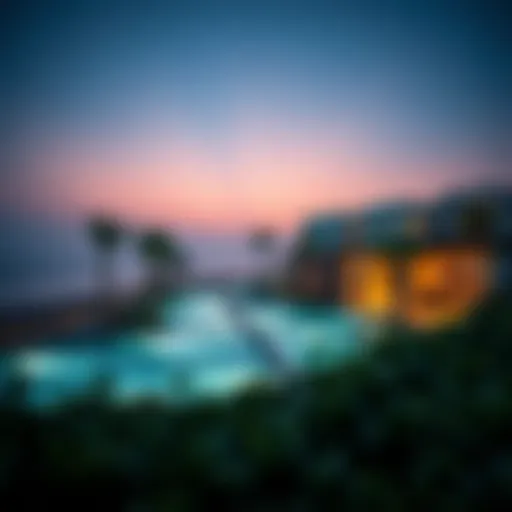Discovering Al Fahidi Historical Neighborhood: A Cultural Insight


Intro
The Al Fahidi Historical Neighborhood, often whispered about among locals and travelers alike, embodies something that transcends mere bricks and mortar. Nestled in the heart of Dubai, it offers a portal back to a time when the pace was slower, and life revolved around community and tradition. Visitors can sense the stories echoing off its coral block walls, which date back to the late 19th century.
This section will outline the winding paths of Al Fahidi, where every alley tells tales of merchants, craftsmen, and the resilience of a culture that adapted to the tides of change. As Dubai embarks on a relentless march toward modernization, this neighborhood stands as a bastion of heritage, subtly reminding us of the rich tapestry of history that forms the skyline of one of the world's most dynamic cities.
Understanding Al Fahidi is not merely an academic exercise; it’s crucial for investors, buyers, agents, developers, and expatriates keen on the evolving landscape of Dubai's real estate market. The architectural styles, cultural influences, and preservation efforts lend a unique flavor to the property market here.
Get ready to dive deep into this fascinating area. Through analyzing current trends, investment opportunities, and hints of modernization, we will explore the Al Fahidi Historical Neighborhood's relevance in both historical and contemporary contexts.
Prelude to Al Fahidi Historical Neighborhood
The Al Fahidi Historical Neighborhood, often simply known as Al Fahidi, emerges as a cornerstone in Dubai's historical and cultural narrative. It serves as a bridge between the bustling present of this metropolitan hub and its rich past. Some might say it’s like walking through a time machine, where the sights and sounds transport you to an era long ago.
Understanding the significance of this neighborhood goes beyond mere architecture; it encapsulates the spirit of a city that has evolved dramatically over the decades. One might consider the intricate alleyways and wind-tower structures to be storytellers, narrating tales of resilience, heritage, and community. Each building holds fragments of history that speak volumes about the traditional way of life that once defined this region.
Benefits of Exploring Al Fahidi
- Cultural Insight: Visitors gain a deeper appreciation for Dubai's roots, understanding how its heritage influences contemporary culture.
- Architectural Appreciation: The blend of traditional and modern design provides a unique perspective on the city’s evolution.
- Community Engagement: Al Fahidi fosters community spirit through numerous cultural events and interactions with local artisans.
But it's not just about what meets the eye; it’s about the stories and experiences that shape perceptions. The Al Fahidi Historical Neighborhood is a testament to Dubai's commitment to preserving its identity amidst rapid modernization. As investors, developers, and expatriates explore opportunities in this area, they are not just looking at real estate but at being part of a legacy worth preserving.
Moreover, as this neighborhood continues to play a pivotal role within the broader context of Dubai’s urban landscape, its importance is amplified in discussions of sustainable development and cultural preservation. The preservation efforts that are taking place here ensure that future generations can appreciate why Al Fahidi isn’t just a place—it's a living museum.
Architectural Features of Al Fahidi
The architectural features of Al Fahidi are not just walls and roofs; they are a narrative engraved in every corner. Each structure whispers tales of a bygone era, with a design ethos that respects the harsh desert climate, ensuring comfort for its inhabitants. The significance of these features cannot be overstated, as they serve as a bridge between the rich cultural heritage of Dubai and the challenges posed by modern growth. This section offers a deep dive into the essence of Al Fahidi’s architectural identity, with a particular focus on traditional wind towers, the use of local materials, and design influences from neighboring regions.
Traditional Wind Towers
One of the most captivating architectural elements found in Al Fahidi is the traditional wind tower, known locally as "Barjeel.” These structures act as natural air conditioning systems, capturing the gentle breezes that flow through the narrow alleys. A typical wind tower rises above the buildings and is ingeniously designed to channel cooler air down into the living spaces below.
The design features long openings facing the prevalent winds, which allows for efficient airflow, while the thick clay walls of the surrounding structures provide insulation against the sweltering heat of the summer sun. This method demonstrates local ingenuity and reflects a keen understanding of environmental conditions.
"The wind towers of Al Fahidi are not just functional; they symbolize the harmonious relationship between the residents and their environment."
The sustainable nature of this design can be a case study for modern urban planners, especially in regions grappling with climate change. Such features pave the way for an eco-friendly architectural approach, sparking interest among developers and investors who recognize the value of sustainability in real estate.
Use of Local Materials
Al Fahidi’s buildings showcase an impressive utilization of local materials like coral stone, gypsum, and palm fronds. These resources were not only abundant but also suited to the environmental demands of the region. For instance, coral stone, sourced from the Persian Gulf, possesses natural insulating properties. When used in construction, it helps maintain a conducive indoor temperature, particularly crucial during the peak summer months.
Using locally available materials also promotes the preservation of local craftsmanship, providing communities with job opportunities and sustaining artisanal traditions. This choice stands in contrast to the contemporary construction trends that often lean on imported materials, embedding a profound sense of place into the very fabric of Al Fahidi. Moreover, in a market increasingly focused on sustainability, this practice can resonate well with potential buyers and investors looking for authenticity in their investments.
Design Influences from Neighboring Regions


The design of Al Fahidi’s architecture is not an isolated phenomenon; it exhibits distinct influences from neighboring regions such as Iran and the Arabian Peninsula. The use of intricate carvings and geometric patterns seen on the building facades reflects a fusion of cultures. This blend not only enhances the aesthetic appeal but also serves as a testament to the historical trade routes that once flourished in the region.
The adaptations made by local builders, borrowing from various architectural styles, signify a broader narrative of cultural exchange and adaptation. As Dubai progresses into a global city, maintaining this architectural dialogue becomes vital. For real estate stakeholders, an appreciation of these influences may offer insight into the community's value proposition and assist in crafting narratives that attract new residents and tourists alike.
Cultural Significance of Al Fahidi
The Al Fahidi Historical Neighborhood holds a treasure trove of cultural significance, making it a crucial part of Dubai's historical tapestry. More than just a collection of buildings, it functions as a living museum, showcasing the traditional Emirati lifestyle and the rich history narrated through architecture and community engagements. The blend of cultural heritage and contemporary practices creates a unique atmosphere, offering both residents and visitors profound insights into the past.
Home to Museums and Cultural Institutions
The crown jewels of Al Fahidi's cultural landscape are undoubtedly its museums and cultural institutions. The Dubai Museum, located in the Al Fahidi Fort, takes visitors on a journey through time. It displays artifacts that speak volumes about the region’s history, from its early days as a coastal trading hub to its modern metamorphosis into a bustling metropolis. The museum is more than just a collection of items; it is a narrative of Dubai's resilience and evolution.
In addition to the Dubai Museum, places like the Sheikh Mohammed Centre for Cultural Understanding transcend the conventional boundaries of cultural education. They offer immersive experiences through workshops, guided tours, and traditional meals, inviting people from diverse backgrounds to engage directly with Emirati culture. Such institutions foster understanding and respect among the multicultural populace of Dubai.
Art Galleries and Art Scene
Al Fahidi thrives as a haven for artists and art enthusiasts. The art galleries scattered throughout the neighborhood are proof that creativity flows here like water in a wadi. The Gallery 76, for instance, often showcases contemporary works that challenge societal norms while reflecting the local culture. This is a space where established artists and emerging talents often intermingle, sparking collaborations and innovative projects that resonate with the community's identity.
Ultimately, the art scene is not only a platform for cultural expression but also a commercial frontier for investors and developers who see potential in nurturing creative industries. In a world where art connects cultures, Al Fahidi stands at the forefront, offering numerous opportunities for collaboration and investment.
Influence on Local Arts and Crafts
In the realm of traditional crafts, Al Fahidi is a bastion of heritage. The area is home to artisans who meticulously practice time-honored methods, whether it be in textile weaving, pottery, or calligraphy. The local markets often feature hand-crafted goods that tell the story of generations. By preserving these crafts, the community ensures that the skill sets of the past remain vibrant and relevant today.
Moreover, cultural festivals and workshops dedicated to artisanship are common here, making it a lively hub for both learning and appreciation. This environment not only enhances local economic prospects but also reinforces a sense of identity and belonging for residents.
In summation, the cultural significance of Al Fahidi goes beyond bricks and mortar; it encompasses the soul of Dubai, striking a delicate balance between honoring the past and embracing the future. The neighborhood serves as a vital link, connecting the rich history of the Gulf region with its dynamic present, all while setting the stage for a promising tomorrow.
The ongoing dialogue between culture and commerce in Al Fahidi creates fascinating avenues for investors and stakeholders. As the neighborhood continues to evolve, its cultural significance will undoubtedly shape Dubai's urban landscape for years to come.
Modernization and Development
The interplay of modernization and development within Al Fahidi Historical Neighborhood highlights a pivotal chapter in Dubai's narrative. This section underscores the significance of these forces in a locale that thrives on its rich past while embracing the potential of the future. The developments here are not just mere constructs of concrete and steel; they are reflections of a society striving to honor its heritage while advancing into the global arena.
Impact of Tourism
Tourism has become a lifeblood for Al Fahidi, bringing a blend of local charm and international aspirations. The influx of visitors reshapes the neighborhood's economic landscape. When tourists stroll through the narrow lanes, they are not just visiting a historic site; they are engaging with the very essence of Dubai’s cultural tapestry.
- Economic Boost: Local businesses, from traditional cafes to artisan shops, feel the ripple effect of increased foot traffic. Tourists often are on the lookout for unique experiences, and Al Fahidi caters to this desire by providing immersive cultural interactions.
- Cultural Exchange: With numerous expatriates and worldwide visitors frequenting the neighborhood, tourism fosters a cultural dialogue. This exchange of ideas and customs brings a fresh breath to the traditional environment, strengthening Al Fahidi's appeal as a cultural hotspot.
Nevertheless, the surge in tourism also necessitates a careful approach to preserve the integrity of this historical gem.
Integration with Urban Development
Urban development and historical preservation might seem like oil and water, but in Al Fahidi, they are finding ways to coexist. The integration of modern infrastructure while retaining historical charm is a delicate balance.
A few notable points regarding this integration include:


- Smart City Initiatives: The local government is keen on adopting smart technologies to improve urban living. Yet, these technologies are being embedded subtly to ensure they do not overshadow the district's authenticity.
- Transport Links: Enhanced connectivity is essential. The inclusion of modern transport facilities improves access to Al Fahidi, making it easier for residents and tourists alike, while still maintaining the pedestrian-friendly environment that characterizes the neighborhood.
In this framework, urban developers are increasingly recognizing that they can build alongside history rather than in place of it.
Challenges of Balancing Heritage and Modern Needs
The quest to marry modernization with heritage comes laden with challenges. Striking this balance is crucial not just for the sustainability of Al Fahidi but also for its identity.
Some significant challenges include:
- Gentrification Risks: The allure of modern real estate developments might push traditional residents out, creating a loss of cultural continuity. Maintaining affordable housing and local businesses is paramount.
- Cultural Authenticity: As new establishments arise, there’s a risk that the neighborhood may start to lose its character. Developers and local authorities face the tough task of ensuring that new projects respect and reflect the heritage.
- Community Engagement: Involving locals in the decision-making process about developments ensures that any changes resonate with those who call Al Fahidi home. Active participation can help safeguard the neighborhood's unique identity.
"Preserving history while pushing towards the future is like walking a tightrope. One misstep and you risk losing both the past and the promise of progress."
Preservation Efforts in Al Fahidi
The Al Fahidi Historical Neighborhood occupies a special place in the architectural and cultural tapestry of Dubai. As this dynamic city advances and reshapes itself, preserving Al Fahidi becomes crucial. Preservation efforts not only safeguard the physical structures but also protect the stories woven into the fabric of the community. By maintaining this area’s heritage, the neighborhood serves as a time capsule, revealing the essence of Dubai's past amidst its present and future.
Role of Government Initiatives
One cannot discuss preservation without mentioning the vital role of government initiatives. Dubai's government has implemented various programs aimed at preserving Al Fahidi. These initiatives include funding for restoration projects, regulations ensuring that new constructions complement existing architecture, and promoting awareness about the neighborhood's historical significance.
For instance, the Dubai Culture and Arts Authority oversees projects that breathe new life into crumbling buildings, ensuring they meet both aesthetic and structural requirements. This has often involved collaborating with local architects who understand the importance of maintaining traditional elements, such as the intricate designs typical of the Emirati style. The government’s commitment to these efforts is critical as it provides the necessary resources and framework for sustainable preservation.
Community Involvement in Preservation
Moreover, community involvement plays a pivotal role in maintaining the spirit of Al Fahidi. Local residents and business owners actively participate in various events that foster community spirit and pride in their heritage. Workshops, guided tours, and festivals celebrate the neighborhood’s rich cultural landscape, drawing attention to its historical gems.
Residents often take it upon themselves to organize clean-up campaigns and restoration projects, showcasing a strong sense of ownership over their environment.
"It’s not just about preserving the buildings; it’s about keeping the memories alive," shared a long-time resident of Al Fahidi, underscoring the emotional connection that the community has with their surroundings. This grassroots involvement is essential, as it encourages dialogue between the community and authorities, leading to more sustainable preservation practices that reflect the needs and aspirations of those who live there.
Ultimately, as Al Fahidi adapts to modern demands, both government initiatives and community efforts need to work hand-in-hand. This synergy will ensure that the charms of Al Fahidi continue to enchant future generations while providing a foundation for contemporary urban living.
Real Estate Opportunities in Al Fahidi
The landscape of real estate in Al Fahidi Historical Neighborhood is as dynamic as the neighborhood's rich history. Historically known for its traditional dwellings and cultural essence, Al Fahidi is now witnessing a subtle transformation. This transformation presents a unique opportunity for investors, buyers, and developers. With its intricate tapestry of heritage and modernity, the real estate aspect is not just about transactions but also about preserving a cultural icon.
Investors looking to plunge into this vibrant market will find that the neighborhood's charm offers significant draw for expatriates, buyers, and those keen on cultural immersion. The interplay between residential and commercial opportunities makes it a multifaceted investment target. While the allure of old-world charm attracts homebuyers, the growing interest in cultural tourism sets the stage for lucrative commercial ventures.
Residential Options and Market Trends
Residential options in Al Fahidi remain a blend of traditional architecture and modern living. The historic buildings are not just remnants of the past; many have been lovingly restored and adapted for contemporary living. Expats often seek these refurbished homes to experience a slice of history without sacrificing modern conveniences.
- Key Residential Features: The homes typically boast traditional materials such as coral stone and gypsum, combined with modern-day amenities. Residents enjoy spacious courtyard layouts, which are ideal for social gatherings—adding to the community feel.
- Market Trends: The real estate market in Al Fahidi has observed a steady growth trend. Property values have seen a slight increase, particularly with the rise of cultural tourism. Demand often spikes during the cooler months when tourists flock to Dubai, and more expats consider living in a culturally rich area. Buyers often report that the uniqueness of Al Fahidi homes—paired with its artistic vibe—creates a haven that feels exclusive yet welcoming.


Commercial Investments and Development Potential
The development potential for commercial investments in Al Fahidi is intriguing and multifaceted. Given its significance as a cultural hub, businesses that align with the area's character tend to thrive. Establishing galleries, boutique shops, and cafés that highlight local art and cuisine can attract both tourists and locals, ensuring a steady flow of clientele.
- Viable Business Opportunities:
- Art galleries showcasing local artists can not only draw in tourists but also create a community spot for cultural gatherings.
- Cafés with traditional Emirati dishes can serve as more than eateries; they become cultural experiences.
Moreover, as more developments rise to meet the needs of modern consumers, the challenge lies in ensuring these changes respect Al Fahidi's heritage. Concerted efforts by the government and community participation create a balancing act between progress and preservation. This ongoing dance gives rise to novel commercial real estate ventures, where preserving the historical essence of Al Fahidi becomes both a business strategy and cultural responsibility.
In the vibrant dance of tradition and modernity, Al Fahidi stands as a testament to sustainable investment that respects its roots while looking forward.
Thus, the real estate opportunities in Al Fahidi show a distinctive promise, whether one is looking to buy a home with history or invest in a commercial endeavor anchored in cultural significance. Here, the past and present coalesce, offering lucrative avenues for thoughtful investors.
The Future of Al Fahidi Historical Neighborhood
The future of Al Fahidi Historical Neighborhood represents not just an evolution of bricks and mortar but a fundamental blending of the cultural and the contemporary. As one of Dubai’s most cherished heritage sites, the neighborhood is at a crossroad where the past and present are inquiring how to coexist in harmony. This section examines what’s on the horizon for Al Fahidi, focusing on potential transformations, urban integration, and its lasting impact on Dubai’s identity.
Anticipated Changes and Developments
The landscape of Al Fahidi is poised for noteworthy transformation, driven by increasing interest from both locals and expatriates. This growth is underpinned by several factors, including the tourism boom in Dubai and a renewed appreciation for cultural heritage.
- Tourism Growth: As Dubai becomes a global hub for tourism, Al Fahidi's intimate charm is likely to attract more visitors. This influx demands an enhancement in amenities while maintaining the area's authenticity.
- Infrastructure Improvements: Anticipated upgrades include improved pathways and public transport connections, which seamlessly integrate Al Fahidi within the larger urban fabric of Dubai. Enhanced accessibility will not only benefit tourists but also locals.
- Culinary and Retail Ventures: New cafés and boutiques could start springing up, reflecting Al Fahidi’s character while fostering local entrepreneurship. Such developments could create a lively streetscape that attracts foot traffic.
By embracing these changes, Al Fahidi can offer a rich tapestry of experiences while ensuring that its unique historical landscape is not overshadowed but enriched.
The Role of Al Fahidi in Dubai's Urban Landscape
Al Fahidi's role in Dubai’s urban landscape is multi-faceted, serving as a dynamic juxtaposition to the city’s modern architecture. This historical neighborhood becomes vital in several ways:
- Cultural Anchor: It’s a vivid reminder of Dubai’s roots, playing a crucial part in the city's narrative. As urban development takes shape, Al Fahidi stands as a testament to the city’s commitment to preserving cultural identity amid progress.
- Artistic Hub: With rising trends in creative sectors, Al Fahidi is emerging as a nucleus for arts and cultural activities. This could foster an environment where artists, artisans, and tourists collaborate, leading to innovative projects and experiences.
- Community Identity: Residents and expatriates often seek spaces that resonate with authenticity and uniqueness. Al Fahidi, with its rich heritage, characterizes a sense of belonging. It enables the diverse population of Dubai to engage with their roots meaningfully.
End
Reflecting on Al Fahidi Historical Neighborhood offers a unique lens to view the interplay between history and modernity. This neighborhood isn't just a scattering of beautifully crafted buildings; it embodies the spirit of Dubai, where the echoes of the past resonate through the shadows of modern skyscrapers.
As we journey through the streets, each corner tells a story—a story laden with culture, resilience, and transformation. The lush cultural tapestry we find here reminds us that preserving heritage is not merely an act of maintaining the old but also a commitment to enriching the present.
Reflecting on the Blend of Past and Present
In observing Al Fahidi, one cannot help but notice how history harmonizes with contemporary life. The traditional architecture, characterized by wind towers and limestone walls, coexists with modern art galleries and cafes buzzing with energy. This blend is not forced; instead, it flows naturally, much like Dubai's own evolution. Visitors find original structures housing contemporary exhibitions, breathing new life into spaces that carry centuries of narratives.
This integration serves not only as a reminder of where Dubai came from but also as a foundation for where it’s headed. The balance struck here offers lessons for other areas experiencing rapid growth. How one respects tradition while welcoming new ideas can define a community's identity.
Final Thoughts on Al Fahidi's Importance
In the grand scheme, Al Fahidi Historical Neighborhood stands as a crucial element in Dubai's broader narrative. It serves as a mirror reflecting the city’s aspirations—balancing cultural integrity and the pursuit of progress. For investors, buyers, agents, and developers, this area presents not just an opportunity for investment but a chance to participate in an ongoing dialogue about urban heritage and its role in a vibrant future.
Ultimately, engaging with Al Fahidi means acknowledging the city's journey—a journey filled with cultural richness that paints a hopeful picture for future generations. This neighborhood does not merely attract attention for its architecture; it invites one to pause and consider the past while stepping boldly into tomorrow.
"The past is not a dead thing, but a living part of our ongoing story."
For further reading, consider visiting resources such as Wikipedia or exploring government sites that detail preservation efforts enhancing cultural landscapes. Keep an eye out for local events and workshops—participation can heighten communal ties, further weaving Al Fahidi into the fabric of modern Dubai.





